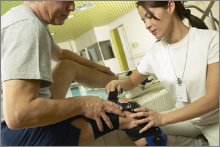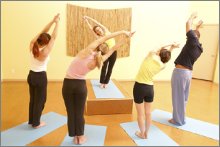Do You Have Arthritis? Here is the Latest on What Experts Know -- and Don't Yet Know
by www.SixWise.com
Arthritis, the leading cause of disability in the United
States, manifests in more than 100 different forms, the most
common being osteoarthritis, gout, rheumatoid arthritis, and
fibromyalgia.
|

The risk of arthritis increases with age, but the disease
can affect anyone -- from children to adults.
|
It's estimated that this painful disease affects one in five
Americans, or a total of 46 million people, according to the
U.S. Centers for Disease Control and Prevention (CDC). As
the population ages, these numbers are expected to keep rising.
By 2030, experts believe 67 million people will have arthritis.
Arthritis is Not an "Old-Age" Disease
Though arthritis is more common in older people (and women),
nearly two-thirds of people with arthritis are younger than
65. Arthritis can affect young adults, 20-somethings and middle-aged
people. Even children can be affected; over 300,000 children
have some form of juvenile arthritis, according to the Arthritis
Foundation.
Because it affects such a wide group of people, and can cause
debilitating symptoms, arthritis is fast becoming one of the
nation's leading public health problems. According to the
CDC:
-
Close to 19 million U.S. adults said their activities
were limited by arthritis from 2003 to 2005.
-
More than 5 percent of the U .S. population has work
limitations because of arthritis.
-
More than 30 percent of people with arthritis report
work limitations due to the disease.
-
Arthritis results in 750,000 hospitalizations and 36
million out-patient visits every year.
-
Medical costs directly related to arthritis reached $81
billion in 2003, with total costs reaching $128 billion.
What Exactly IS Arthritis?
Each of the 100-plus forms of arthritis is unique in its
exact cause and symptoms, but there is a commonality. Arthritis
means "joint inflammation," and all arthritic conditions
affect the musculoskeletal system and, in particular, the
joints (where two or more bones meet).
In people with arthritis, the joints can become painful,
stiff and inflamed, and joint cartilage and surrounding structures
can become damaged. This can lead to weakness in the joints,
instability and deformities that can make daily tasks -- from
walking to cutting your food or typing on a computer -- very
difficult.
Some forms of arthritis do not stop at the joints, however.
Systemic arthritic conditions can affect your entire body
and cause damage to any organ or bodily system, including
the heart, lungs, kidneys, blood vessels and skin.
Here is breakdown of the most common type of arthritis, according
to the Arthritis Foundation:
-
Osteoarthritis: This is a degenerative joint disease
in which the cartilage that covers the ends of bones in
the joint deteriorates, leading to pain and loss of movement
because bone begins to rub against bone. (This is the
most common form of arthritis in the United States).
-
Rheumatoid arthritis: This is an autoimmune disease in
which the joint lining becomes inflamed due to the body's
immune system activity. (This is one of the most debilitating
types and appears most often in women.)
-
Gout: This painful condition is often due to a defect
in body chemistry that affects small joints, particularly
the big toe. (Gout occurs most often in men.)
-
Fibromyalgia: This condition involves widespread pain
that affects the muscles and attachments to the bone.
It is more common in women.
|
Stop Arthritis Pain in Minutes With
BlueStop MAX Arthritis Pain Gel

BlueStop MAX Arthritis Pain Gel contains key ingredients,
including Cetylated Fatty Acids (CFA) and MSM (Methylsulfonylmethane),
which have been proven to lessen pain and improve flexibility
and function in people with arthritis.
BlueStop is a natural, proven topical gel that will
relieve your pain in minutes.
For
a Limited Time, Buy One BlueStop MAX and Get One FREE!
|
Treating Arthritis: What are the Options?
There is currently no "cure" for arthritis, but
there are many ways to manage the condition and still lead
an active life. To treat the pain and inflammation associated
with arthritis, pain-relievers (both over-the-counter and
prescription) and anti-inflammatory drugs are often prescribed.
As a last resort, doctors may also recommend joint surgery
to repair damaged joints or replace them.
However, there are many natural methods to lessen the pain
and other symptoms of arthritis, and to protect your body
from damage.
While people with arthritis should rest their joints if they
feel fatigued, too much rest can actually worsen the condition.
A regular exercise program is highly recommended for anyone
with arthritis, not only to help you maintain a healthy weight
(a must to protect your joints) but also to benefit your joints
directly. Your exercise routine should include:
-
Range-of-motion exercises: Yoga,
stretching
and dance can help increase flexibility, relieve stiffness
and maintain normal joint movement.
-
Aerobic and endurance exercises: Walking, bike
riding or using an elliptical machine can reduce inflammation
in your joints and help control your weight.
-
Strengthening exercises: Strength
training helps to keep your muscles strong, which
will support and protect your joints.
|

Yoga is highly recommended for people with arthritis
to increase flexibility, keep joints moving properly
and relieve stiffness.
|
Eating a healthy diet is also incredibly important to maintain
your weight and benefit your overall health. Focusing on getting
plenty of fruits
and vegetables, which are naturally
anti-inflammatory, may also help.
Beyond exercise and eating right, the following natural methods
can help to relieve the pain and stiffness associated with
arthritis:
-
Use hot or cold packs. Heat relaxes muscles, cold reduces
inflammation and swelling.
-
Use BlueStop
MAX Arthritis Pain Gel. This natural topical gel contains
Cetylated Fatty Acids (CFA), which are known to improve
flexibility and function in patients suffering from inflamed
joints and muscles, and MSM (Methylsulfonylmethane), which
helps to alleviate pain from systemic inflammation disorders,
like arthritis.
-
Get regular massages.
-
Try relaxation
techniques like meditation, prayer, guided imagery
and relaxation
CDs.
-
Consider alternative treatments. Biofeedback can help
you to become more aware of your body's reaction to pain,
and may help you learn how to control the reactions. Acupuncture,
which involves inserting small needles into specific points
on your body, can also help to relieve pain.
Finally, if you have arthritis pay attention to your body.
If you feel fatigued, don't push yourself, and be careful
not to strain your joints (such as to open a jar). Do things
that will make your life easier (like using a jar opener or
having someone open the jar for you) and whenever possible
use your large muscles and large joints to perform daily tasks.
Above all else, remember that arthritis is a condition that
you can manage. Staying optimistic and positive about the
future will ensure that you stay in control of the condition
and, studies have found, will help you experience less pain
and make fewer visits to the doctor.
Recommended Reading
14
Fruits and Vegetables That Provide the Best Protection Against
Arthritis
To
Fight Osteoarthritis & Multiple Other Chronic Diseases,
Make Sure You Get Enough Selenium
Sources
U.S.
Centers for Disease Control and Prevention
National
Institute of Arthritis and Musculoskeletal and Skin Diseases
Arthritis
Foundation